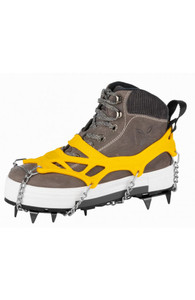
Snowshoes are specialised footwear that strap onto your boots and allow you to walk on top of snow without sinking deeply. They work by spreading your weight over a larger surface area, reducing what's called "postholing" (sinking into deep snow).
Main Purpose:
To make walking on snow easier and more efficient, especially in deep, soft, or unpacked snow.
Parts of a Snowshoe:
| Part | Function |
|---|---|
| Frame | The outer structure, often made of aluminum or composite materials. |
| Decking | The surface stretched within the frame that provides floatation. |
| Binding | Straps or harnesses that attach the snowshoe to your boot. |
| Crampons/Traction Rails | Metal spikes underneath for grip on icy or uneven terrain. |
| Heel Lift Bar (optional) | A flip-up bar under the heel that reduces calf fatigue on steep uphill climbs. |
Types of Snowshoes:
| Type | Best For |
|---|---|
| Recreational Snowshoes | Flat or rolling terrain, casual hiking. |
| Backcountry Snowshoes | Steeper, rugged terrain; more durable with better traction. |
| Running Snowshoes | Lightweight and narrow for snow running or racing. |
Who Uses Snowshoes?
-
Winter hikers
-
Backcountry travellers
-
Hunters and wildlife photographers
-
Avalanche professionals
-
People exploring snowy areas without skis
Fun Fact:
Snowshoes have been used for thousands of years by Indigenous peoples in snowy regions. Modern versions are lighter, more durable, and optimized for performance and comfort.
Important Tips:
-
Wear waterproof boots with good ankle support.
-
Use trekking or ski poles for added balance.
-
Know avalanche risks if traveling in the backcountry—even snowshoes don’t prevent avalanches.
In Summary:
Snowshoes let you walk efficiently on snow by distributing your weight, preventing deep sinking, and providing traction. They're a great tool for winter travel, fitness, or simply exploring snowy landscapes.
